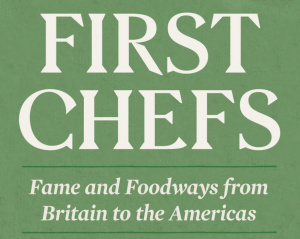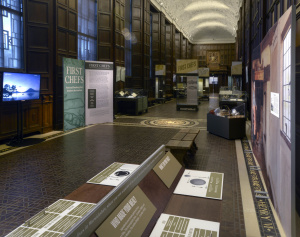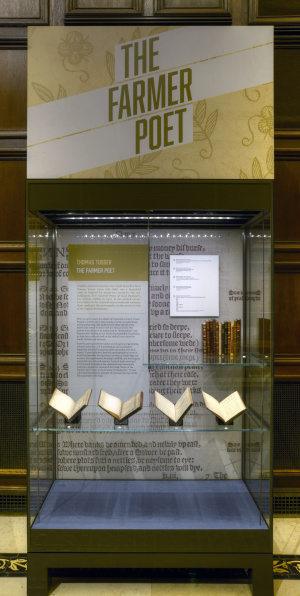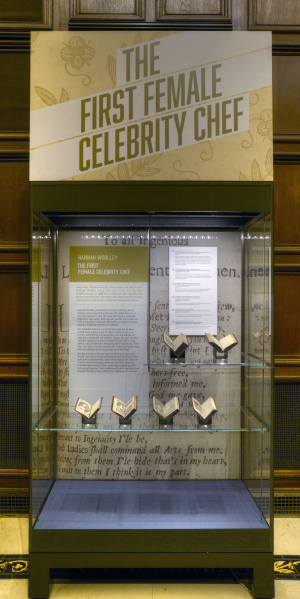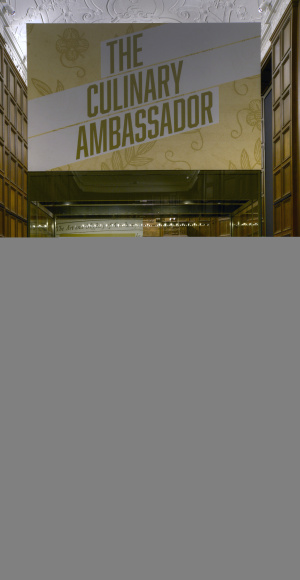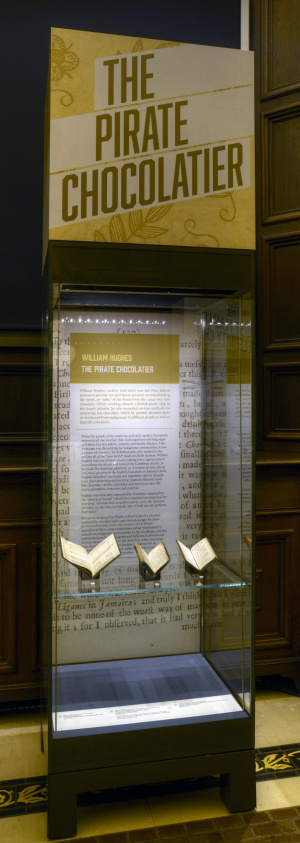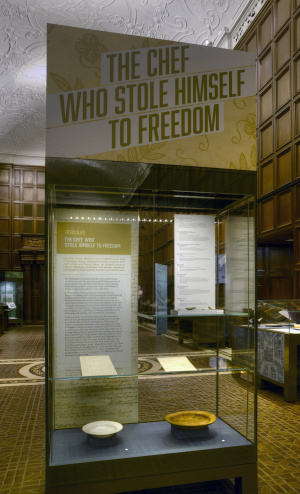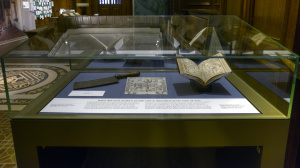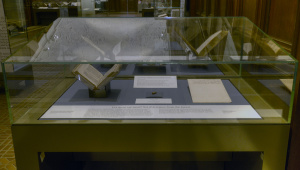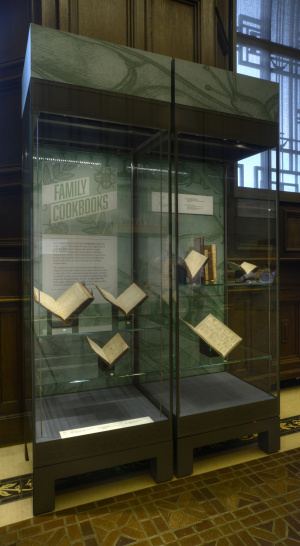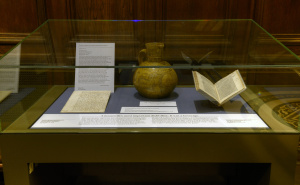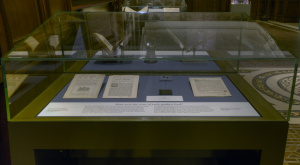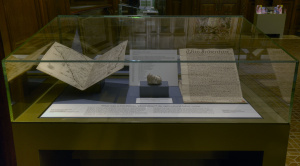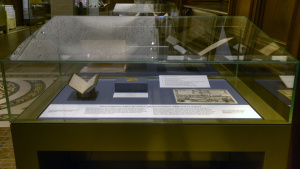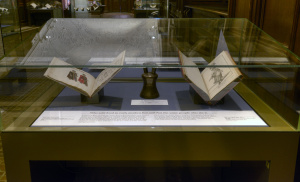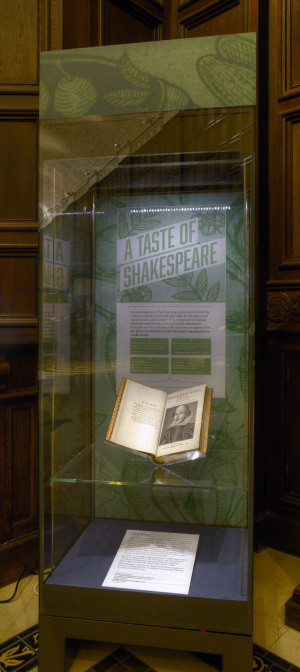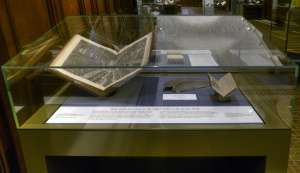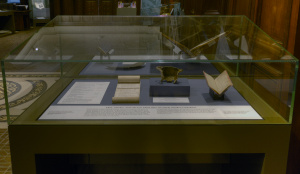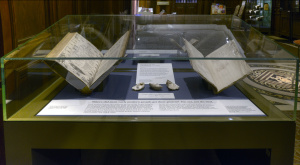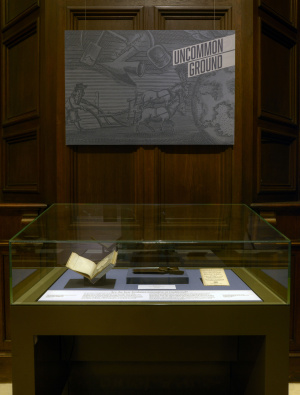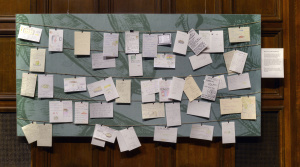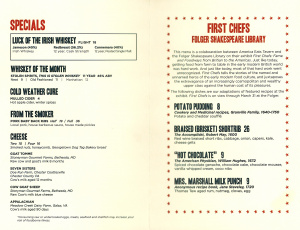First Chefs: Fame and Foodways from Britain to the Americas
First Chefs: Fame and Foodways from Britain to the Americas, one of the Exhibitions at the Folger, opened on January 19, 2019 and closed on March 31, 2019. First Chefs was co-curated by Associate Director for Fellowships at the Folger Institute Amanda E. Herbert and Curator of Manuscripts and Associate Librarian of Audience Development Heather Wolfe, with assistance from Elizabeth DeBold, the Assistant Curator of Collections at the Folger Shakespeare Library. This exhibition was done in association with Before ‘Farm to Table’: Early Modern Foodways and Cultures, an Andrew W. Mellon Foundation initiative in collaborative research at the Folger Institute.
First Chefs told the stories of the named and unnamed heroes of early modern food culture, and juxtaposes the extravagance of an increasingly cosmopolitan and wealthy upper class against the human cost of its pleasures: the millions of enslaved women, children, and men, servants, gardeners, street criers, and laborers who toiled to feed themselves and many others.
Along the walls of the exhibition, the lives of early modern women and men—rich as well as poor, free and enslaved—who found, made, and ate food were revealed. Through their eyes, the exhibition explored gardens and farms, forests and rivers, plantations and fisheries, markets, kitchens, food stalls, and dining halls. At the center of the exhibition were the five “First Chefs,” whose stories were told through their written, material, and imagined legacy.
An interactive screen allowed visitors to page through digitally replicated versions of several of the Folger's manuscript receipt books, the largest collection of seventeenth-century English-language recipe books in the world. This interactive piece was created by Rebecca Niles.
Curation
Amanda E. Herbert is Associate Director at the Folger Institute of the Folger Shakespeare Library, where she runs the Fellowships Program. She holds the M.A. and Ph.D. degrees in History from the Johns Hopkins University. She is a historian of the body: gender and sexuality; health and wellness; food, drink, and appetite. Her first book, Female Alliances: Gender, Identity, and Friendship in Early Modern Britain, was published by Yale University Press in 2014, and won the Best Book Award from the Society for the Study of Early Modern Women. She has published articles in Gender & History, the Journal of Social History, and Early American Studies, and her fellowships include grants from the American Antiquarian Society, the Huntington Library, and the Yale Center for British Art. She is an editor for The Recipes Project, a Digital Humanities effort based out of the Max Planck Institute in Berlin, and a co-director for Before 'Farm to Table': Early Modern Foodways and Cultures, a $1.5 million Mellon Foundation Initiative in Collaborative Research at the Folger Institute. She is at work on her second book project, Water Works: Faith, Public Health, and Medicine in the British Atlantic, which seeks to refigure and reclaim the early modern spa, not just as a place of elite sociability, but as an important site for the study of the history of public health.
Heather Wolfe is Curator of Manuscripts and Associate Librarian of Audience Development at the Folger Shakespeare Library. She received an MLIS from UCLA and a PhD from the University of Cambridge. She is currently principal investigator of Early Modern Manuscripts Online, co-principal investigator of Shakespeare’s World, curator of Shakespeare Documented, and is co-director of the multi-year, $1.5 million research project Before 'Farm to Table': Early Modern Foodways and Cultures, a Mellon initiative in collaborative research at the Folger Institute of the Folger Shakespeare Library. Her first book, Elizabeth Cary, Lady Falkland: Life and Letters (2000) received the Josephine Roberts Scholarly Edition Award from the Society for the Study of Early Modern Women. She has written widely on the intersections between manuscript and print culture in early modern England, and also edited The Trevelyon Miscellany of 1608 (2007), The Literary Career and Legacy of Elizabeth Cary (2007), and, with Alan Stewart, Letterwriting in Renaissance England (2004). Her most recent research explores early modern filing systems and the social circulation of writing paper and blank books.
Elizabeth DeBold is the Assistant Curator of Collections at the Folger Shakespeare Library. As a member of the curatorial team, she has assisted with numerous projects and exhibitions, including Shakespeare Documented, Shakespeare, Life of an Icon, and Beyond Words: Book Illustration in the Age of Shakespeare. Prior to coming to the Folger, she graduated with her Master’s of Science in Library Science from UNC-Chapel Hill, and held a position as part of an IMLS-funded grant at the Duke University Divinity School Library.
To read the insights of the curators alongside some of the objects about which they are discussing, visit our First Chefs’ curator’s insights page.
Contents of the Exhibition
Gallery Layout
The exhibition took place in the Great Hall of the Folger Shakespeare Library, and was designed by Shveima Associates.
Case 1: Thomas Tusser: The Farmer Poet
A highly-educated musician who taught himself to farm, Thomas Tusser (circa 1524-1580) was a household name in England for nearly two centuries. His only publication, Five Hundred Points of Good Husbandry, was written entirely in verse. It was printed twenty-seven times in the sixteenth and seventeenth centuries alone, making it the most popular secular poetical work of the English Renaissance.
In this case, we displayed several different editions of his famous work to get a taste of Tusser’s popularity over time and his understanding of agriculture.
Items Included
- Tusser, Thomas, Fiue hundreth points of good husbandry : vnited to as many of good huswiferie, first deuised, [and] nowe lately augmented with diuerse approued lessons concerning hopps [and] gardening, and other needeful matters, together with an abstract before euery moneth, conteining the whole effect of the sayd moneth with a table [and] a preface in the beginning both necessary to be reade, for the better vnderstanding of the booke. 1573. STC 24377.
- Tusser, Thomas. Five hundred points of good husbandry. : As well for the champion or open countrey, as also for the vvoodland or seuerall, mixed in euery moneth with huswifery, ouer and besides the booke of huswifery. Corrected better ordered and newly augmented to a fourth part more, with diuers other lessons, as a dyet for the farmer, of the properties of winds, plants, hops, hearbs, bees & approued remedies for sheepe and cattle; with many other matters both profitable, & not vnpleasant for the reader. Also two tables, one of husbandry, and the other of huswifery, at the end of the booke, for the better and easier finding out of any matter contayned in the same. 1630. STC 24391.
- Tusser, Thomas. Five hundred points of good husbandry. : As well for the champion or open countrey, as also for the woodland or several, mixed in every moneth, with houswifery, over and besides the book of houswifery. Corrected, better ordered, and newly augmented to a fourth part more, with divers other lessons, as a diet for the farmer, of the properties of winds, plants, hops, hearbs, bees, and approved remedies for sheep and cattel; with many other matters both profitable, and not unpleasant to the reader. Also two tables, one of husbandry, and the other of houswifery, at the end of the book, for the better and easier finding out of any matter contained in the same. Newly set forth by Thomas Tusser, gent. 1672. T3369.
- Tusser, Thomas. Five hundred points of husbandry : directing what corn, grass, &c. is proper to be sown, what trees to be planted, how land is to be improved : with whatever is fit to be done for the benefit of the farmer in every month of the year / by Thomas Tusser, esq. ; to which are added, notes and observations explaining many obsolete terms used therein ... ; a work very necessary and useful for gentlemen ... 1744. 189- 493q.
- Tusser, Thomas. Multiple editions of Five hundred points, in chronological order.
- 1573, STC 24375
- 1577, STC 24379
- 1580, STC 24380
- 1586, STC 24382
- 1599, STC 24385.2
- 1610, STC 24388 copy 1
- 1610, STC 24388 copy 2
- 1614, STC 24389
- 1620, STC 24390 copy 1
- 1620, STC 24390 copy 2
- 1638, STC 24392
- 1710. SB97.T9 Cage
Case 2: Hannah Woolley: The First Female Celebrity Chef
Hannah Woolley was one of the most popular English writers to write about household management in the early modern period. She began publishing books in 1661 after becoming a widow. Her four cookbooks were each published (sometimes in unauthorized editions) many times in the later part of the 17th century. She had a cooking school in addition to a publishing empire, and like Robert May (and Shakespeare!), her books featured an author portrait, biographical material, and verses honoring her. She is considered to be the first woman to earn a living as a food writer.
In Hannah Woolley’s case, we included a variety of authorized editions and unauthorized adaptations of her famous works.
Items Included
- Woolley, Hannah. A guide to ladies, gentlewomen and maids : containing directions of behaviour, in all places, companies, relations, and conditions, from their childhood down to old age: viz. As children to parents. Scholars to governours. Single to servants. Virgins to suitors. Married to husbands. Huswifes to the house. Mistresses to servants. Mothers to children. Widows to the world, and as prudent to all. With letters and discourses upon all occasions, with several tales, and the ladies farewell. Whereunto is added, a guide for cook-maids, dairy-maids, chamber-maids, and all others that go to service: the whole being exact rules for the female sex in generall. By Hannah Woolley. 1668. W3278.5.
- Woolley, Hannah. The accomplish’d ladies delight in preserving, physick, beautifying, and cookery. : Containing, I. The art of preserving, and candying fruits and flowers, and the making of all sorts of conserves, syrups, and jellies. II. The physical cabinet, or excellent receipts in physick and chirurgery, together with some rare beautifying waters, to adorn and add loveliness to the face and body: and also some new and excellent secrets and experiments in the art of angling. III. The compleat cooks guide, or, directions for dressing all sorts of flesh, fowl, and fish, both in the English and French mode, with all sauces and sallets; and the making pyes, pasties, tarts, and custards, with the forms and shapes of many of them. 1684. W3271.
- Woolley, Hannah. The compleat servant-maid, or, The young maidens tutor : directing them how they may fit, and qualifie themselves for any of these employments, viz. waiting-woman, house-keeper, chamber-maid, cook-maid, under cook-maid, nursery-maid, dairy-maid, laundry-maid, house-maid, scullery-maid : whereunto is added a supplement containing the choicest receipts, and rarest secrets in physick and chyrurgery / composed for the great benefit and advantage of all young maidens. 1683. W3273.8.
- (Unauthorized adaptation). The compleat servant maid, or, The young maidens tutor : directing them how they may fit, and qualifie themselves for any of these employments, viz. waiting-woman, house-keeper, chamber-maid, cook-maid, under-cook-maid, nursery-maid, dairy-maid, laundry-maid, house-maid, scullery maid : whereunto is added a supplement containing the choicest receipts and rarest secrets in physick and chirurgery / composed for the great benefit and advantage of all young maidens. 1691. 270- 105q.
- Woolley, Hannah. The queen-like closet, or Rich cabinet : stored with all manner of rare receipts for preserving, candying and cookery. Very pleasant and beneficial to all ingenious persons of the female sex. To which is added, A supplement, presented to all ingenious ladies, and gentlewomen. By Hannah Wolley. 1675. W3284.
- Woolley, Hannah. The queen-like closet: or, Rich cabinet : stored with all manner of rare receipts for preserving, candying and cookery. Very pleasant and beneficial to all ingenious persons of the female sex. To which is added, A supplement, presented to all ingenious ladies, and gentlewomen. By Hannah Woolley. 1684. W3286.
Case 3: Robert May: The Culinary Ambassador
Robert May was an English chef who trained in Paris. His book The accomplisht cook was the most extensive collection of recipes to appear in print in England, and the first cookbook to include an author portrait, biography, and commendatory verses. It appeared in five editions between 1660 and 1685, and helped to introduce English people to continental European cuisine.
This case contained various editions of his 1660 work.
Items Included
- LOAN COURTESY OF THE LIBRARY OF CONGRESS. May, Robert. The accomplisht cook, or, The art and mystery of cookery. Wherein the whole art is revealed in a more easie and perfect method, then hath been publisht in any language... An account of all dishes for all seasons of the year, with other a la mode curiosities. 1665. TX705.M46 1665
- LOAN COURTESY OF THE LIBRARY OF CONGRESS. May, Robert. The accomplisht cook, or, The art & mystery of cookery. Wherein the whole art is revealed in a more easie and perfect method, than hath been publisht in any language. Expert and ready wayes for the dressing of all sorts of flesh, fowl, and fish, with variety of sauces proper for each of them; and how to raise all manner of pastes; the best directions for all sorts of kickshaws; also the terms of carving and sewing. An exact account of all dishes for all seasons of the year, with other a la mode curiosities. 1671. TX705.M46 1671
- LOAN COURTESY OF THE LIBRARY OF CONGRESS. May, Robert. The accomplisht cook, or, The art and mystery of cookery : wherein the whole art is revealed in a more easie and perfect method, than hath been publisht in any language : expert and ready wayes for the dressing of all sorts of flesh, fowl, and fish, with variety of sauces proper for each of them, and how to raise all manner of pastes, the best directions for all sorts of kickshaws, also the terms of carving and sewing ... approved by the fifty five years experience and industry of Robert May, in his attendance on several persons of great honour. 1678. TX705.M46 1678 Pennell Coll Copy 1.
- May, Robert. The accomplisht cook, or The art & mystery of cookery. : Wherein the whole art is revealed in a more easie and perfect method, than hath been publisht in any language. Expert and ready ways for the dressing of all sorts of flesh, fowl, and fish, with variety of sauces proper for each of them; and how to raise all manner of pastes; the best directions for all sorts of kickshaws, also the terms of carving and sewing. An exact account of all dishes for all seasons of the year, with other a-la-mode curiosities The fifth edition, with large additions throughout the whole work: besides two hundred figures of several forms for all manner of bak’d meats, either flesh, or fish) as pyes tarts, custards; cheesecakes, and florentines, placed in tables, and directed to the pages they appertain to. Approved by the fifty five years experience and industry of Robert May, in his attendance on several persons of great honour. 1685. MI934.
Case 4: William Hughes: The Pirate Chocolatier
William Hughes was the first British person to provide an eyewitness account on transforming the seeds, or “nibs,” of the fruits from the cacao tree into chocolate. While working aboard a British pirate ship in the South Atlantic, he also recorded various methods for preparing hot chocolate, which he gained, gleaned, stole, or overheard from indigenous Caribbean people as well as Spanish colonizers. His 1672 work, The American physitian, or, A treatise of roots, plants and trees...growing in the English plantation in America, detailed the fruits and vegetables of “new world” that Hughes found most promising and exciting, such as chocolate, vanilla, and chiles.
In this case, we included three different works by Hughes.
Items Included
- Hughes, William. The compleat vineyard: or A most excellent way for the planting of vines : not onely according to the German and French way, but also long experimented in England. Wherein are set forth the whole circumstances necessary for the planting a vineyard, (viz.) the best election of your soil; the scituation thereof; the best way for the planting of your young plants; the best time and manner of proining, both the stocks and roots; the turning and translation of the ground, &c. With all other things necessary to the plant; and the fashion of your wine presses; with the manner of bruising and pressing; and also how to advance our English wines: never before printed. 1665. 152-864q.
- Hughes, William. The American physitian; or, A treatise of the roots, plants, trees, shrubs, fruit, herbs, &c. growing in the English plantations in America. : Describing the place, time, names, kindes, temperature, vertues and uses of them, either for diet, physick, &c. Whereunto is added a discourse of the cacao-nut-tree, and the use of its fruit; with all the ways of making of chocolate. The like never extant before. 1672. 160-266q.
- Hughes, William. The flower garden : shewing briefly how most flowers are to be ordered, the time of flowering, taking of them up, and of planting them again : and how they are increased by layers, off sets, slips, cuttings, seeds, &c. : with other necessary observations relating to a flower garden : vvhereunto is now added, The gardiners or planters dialling, (viz.) how to draw a horizontal diall, as a knot in a garden, on a grass-plot, or elsewhere, the like before not extant. 1672. 206213.
Case 5: Hercules: The Chef Who Stole Himself to Freedom
Born into slavery, Hercules rose to celebrity as the head of President George Washington’s kitchen and the “first chef” of the new United States. He designed meals to impress diplomats, politicians, and foreign dignitaries, and ultimately fled from his fame in order to gain his freedom.
Unlike our other “First Chefs,” Hercules did not author a book. In fact, he disappears from the historical record after his self-liberation from the Washingtons. While much of what we know about Hercules is from the papers of George Washington, Hercules’s legacy cannot be defined by a slave owners paperwork. One way to learn about Hercules is to study objects that recall both his working and personal life. Therefore, we included some of these objects - including bowls, marble, spoon fragments, and more - in the “First Chefs” exhibit.
Items included
- LOAN COURTESY OF THE MOUNT VERNON LADIES’ ASSOCIATION. Washington, George. Account of Articles Bought and Prices Paid. 1794. RM-595.
- LOAN COURTESY OF THE MOUNT VERNON LADIES’ ASSOCIATION. Washington, George. Autograph letter signed to William Pearce. 1796. RM-490-F.
- LOAN COURTESY OF THE MOUNT VERNON LADIES’ ASSOCIATION. Bowl belonging to George and Martha Washington. 18th century. W-2011 A.
- LOAN COURTESY OF THE MOUNT VERNON LADIES’ ASSOCIATION. Chopping bowl from the Washington estate. W-2170.
- LOAN COURTESY OF THE MOUNT VERNON LADIES’ ASSOCIATION. Toy marble. 18th century. 1077-40BB-WTS-00680.
- LOAN COURTESY OF THE MOUNT VERNON LADIES’ ASSOCIATION. Spoon fragment. 18th century. 1007-40CC-WTS-00034.
- LOAN COURTESY OF THE MOUNT VERNON LADIES’ ASSOCIATION. Shoe buckle, fragment. 18th century. 1007-40E-WTS-00089.
- LOAN COURTESY OF THE MOUNT VERNON LADIES’ ASSOCIATION. Pipe fragment. 18th century. 1007-40BB-WTS-00262.
Case 6: The Labors of the Month
Early modern people were more aware of the seasonality of food than we are today. Different agricultural tasks were associated with each month of the year. The “labors of the month” were depicted in many ways, from fine engravings to cheap almanacs. Rich or poor, the labors of the month influenced how you worked and what you ate.
In this case, we included a formal engraving done by the artist Etienne Delaune, and a manuscript copy of that engraving by draper and calligrapher Thomas Fella.
The physical object included in this case was a cleaver, representing the agricultural labor done in the wintertime. This cleaver was a working tool, used for tasks like butchering animals.
Items included
- Delaune, Etienne. “December. The Labours of the Month.” ca. 1561-1572. Folger ART Vol. C96.
- Fella, Thomas. A booke of diveirs devises and sortes of pictures, with the alphabete of letters, deuised and drawne with the pen ... [manuscript]. 1585, 1593-1594, 1622. V.a.311.
- LOAN COURTESY OF WINTERTHUR, Cleaver, 1800-1850, Jefferson and Anne Miller Collection.
Case 7: The Hunt is On!
Hunting was an integral part of aristocratic life, a form of recreation that allowed the elite to show off their wealth, purebred animals, military skills, and powerful alliances. By contrast, poaching—illegal hunting in the forests of wealthy landowners by lower-status people—was a common crime in rural Britain, punishable by imprisonment or worse. The law stated that deer, hares, coneys, and game birds were off limits, excluding the poor from a cheap source of nourishment unless they were willing to risk their lives.
In this case, we included an image of Queen Elizabeth at the end of a hunt preparing to cut open a deer to measure the quality of a venison, and on the right, we displayed a confession written by commoner William Turner, who admitted to hunting deer using mongrel dogs.
We also included a duck call as the physical object in this case. This was both a sound-maker and a tool: a hand-carved duck call, made out of bone, would have attracted waterfowl to the vicinity of people hunting. It was made in England and brought across the Atlantic to Virginia's Jamestown fort.
Items included
- Gascoigne, George. The noble arte of venerie or hunting. : VVherein is handled and set out the vertues, nature, and properties of fiutene sundrie chaces togither, with the order and maner how to hunte and kill euery one of them. Translated and collected for the pleasure of all noblemen and gentlemen, out of the best approued authors, which haue written any thing concerning the same: and reduced into such order and proper termes as are vsed here, in this noble realme of England. The contentes vvhereof shall more playnely appeare in the page next followyng. 1575. STC 24328.
- Papers of the Bagot family of Blithfield, Staffordshire. 1557-1671. L.a.1052.
- LOAN COURTESY OF THE JAMESTOWN REDISCOVERY FOUNDATION. Duck call. JR21158F 6919- JR.
Case 8: The Kitchen Garden
Plants sustained all early modern people. Lower-status people toiled in the gardens of the rich while maintaining their own small vegetable gardens, helping them to feed their families. For the rich, gardening was for leisure and learning; they cultivated rare varietals and collected costly books on plants.
We included John Gerard’s famous herbal, a type of book containing the names and descriptions of botanical specimens, as well as Sir Nathaniel Bacon’s account book, which listed the wages for hundreds of named and unnamed workers who weeded and cared for his gardens.
In addition, we included squash seeds. Evidence of some of the very first food exchanges between indigenous people and British colonizers, these squash seeds were excavated from the site of Virginia's Jamestown fort.
Items included
- Gerard, John. The herball, or, Generall historie of plantes. 1597. STC 11750 copy 6 (folio).
- Estate accounts of Sir Nathaniel Bacon. 1588-1598. E.b.2.
- LOAN COURTESY OF THE JAMESTOWN REDISCOVERY FOUNDATION. Squash seeds. JR2158AA 7838- JR.
Case 9: Family Cookbooks
Both before and after cookbooks started to appear in print, thousands of women of all ages shared, copied, and adapted culinary and medical recipes in handwritten notebooks. Many of these surviving manuscripts contain multiple generations of ownership marks, showing that their recipes were passed among family and friends, in much the same way we share recipes today.
The Folger has over one hundred seventeenth-century English manuscript cookbooks, the largest such collection in the world. The cookbooks in these two cases, carefully created by women, show the wide range of formats and strategies that women used to keep their households well-fed.
Items included
- English cookery and medicine book [manuscript]. ca. 1671-1711. V.b.380.
- Cookbook of Constance Hall [manuscript]. 1672. V.a.20.
- Cookery and medicinal recipes [manuscript]. ca. 1675-1750. V.a.429.
Case 10: Family Cookbooks II
Case 10 was a continuation of the materials included in Case 9.
Items included
- Mrs. Knight’s receipt book [manuscript]. 1740. W.b.79.
- Choyce receits collected out of the book of receits, of the Lady Vere Wilkinson [manuscript]. 1673/4. V.a.612.
- Cookery and medicinal recipes of the Granville family [manuscript]. ca. 1640-ca. 1750. V.a.430.
- Cookbook of Jane Dawson [manuscript]. Late 17th century. V.b.14.
- Cookbook [manuscript]. 17th century. V.a.19.
- Receipt book of Margaret Baker [manuscript]. ca. 1675?. V.a.619.
- Receipt book [manuscript]. ca. 1690-1750. V.a.680.
Case 11: The Imperfect Housewife
Beer and ale were important sources of calories for women, men, and even children. But, as any home-brewer today would tell you, many things might go wrong in the brewing process: ingredients could run out, yeast cultures could die, and sometimes beer just tasted bad. Women had to meet their husband’s or master’s expectations of the “ideal housewife” even when they lacked key ingredients, constantly improvising to avoid punishment.
In this case, we included a heartbreaking letter by Lettice Kynnersley, explaining that her husband punished her for running out of malt and “for not having provision of beer.” Next to that, we included a “housewifery” manual that states that making malt from barley was “the work and care of the woman, for it is house-work.”
We included a jug with a harvest-style inscription as part of this case. This jug would have been used to offer beer to lower-status laborers. When they harvested grain in the summer, beer was a critical source of calories for agricultural workers.
Items included:
- Papers of the Bagot family of Blithfield, Staffordshire [manuscript]. 1428-1671. L.a.598.
- Markham, Gervase. Countrey contentments, or The English husvvife. : Containing the inward and outward vertues which ought to be in a compleate woman. As her skill in physicke, surgerie, extraction of oyles, banqueting-stuffe, ordering of great feasts, preseruing of all sorts of wines, conceited secrets, distillations, perfumes, ordering of wooll, hempe, flax, making cloth, dying, the knowledge of dayries, office of malting, oats, their excellent vses in a family, brewing, baking, and all other things belonging to an houshold. A worke generally approued, and now much augmented, purged and made most profitable and necessarie for all men, and dedicated to the honour of the noble house of Exceter, and the generall good of this kingdome. 1623. STC 17343.
- LOAN COURTESY OF WINTERTHUR. Jug. 1964.0025.
Case 12: New Worlds, New Hungers
Britain’s appetite for “new world” flavors quickly outstripped supply. Merchants, corporations, and government officials met demand by using forced labor, connecting London to a web of trade and production. As indigenous populations collapsed, many kinds of coerced labor were employed in cities and at sea: indentured servants, convicts, prisoners of war, impressed sailors, and - above all - enslaved Africans.
Here, we displayed a royal act for the encouragement of trade to America, as well as William Turner’s contract, committing him to nine years of unpaid work for a Virginia planter. Turner could not write his name; he uses a tentative “mark” rather than a signature. In addition, we displayed dice from the Jamestown Rediscovery Foundation. Excavated at Jamestown, Virginia, these handmade bone dice were brought across the Atlantic by British colonizers, and would have been used to gamble, entertain, and alleviate boredom.
Items included
- An Act for the encouragement of the trade to America. 1711. 157-994q.
- Indentured servant contracts for the colonies of Maryland, Virginia, Pennsylvania and Barbados. 1682-83. V.b.16 (66).
- LOAN COURTESY OF THE JAMESTOWN REDISCOVERY FOUNDATION. Dice. JR 2718n 5259 - JR, JR2718W 5199- JR.
Case 13: Food Chains
Britain’s colonies grew food for the empire. People who owned property in places like Barbados and Jamaica called themselves “planters,” but they rarely did any planting themselves. Instead, they kept indigenous Caribbean people and people of African origin in bondage, subjecting them, and their children, to permanent unpaid agricultural labor and physical and emotional violence. For corporations, merchants, and planters, people could be property, and food was meant for financial gain.
In this case, we included a West Indian Topshell, as well as a map of Barbados which names the “plantations” in the colony, alongside a list of the human “property” of a British shipbuilder from Barbados: the names of seven enslaved women, men, and children. The topshell, an edible mollusk native to Bermuda, was eaten into extinction by British colonizers. The shell displayed here was excavated in Jamestown, Virginia, demonstrating how colonization impacted the globalization of food.
Items included:
- Ligon, Richard. True & Exact History of the Island of Barbados. 1673. Wing L2076.
- Popel, John. Indenture with Pentecost Teague of Philadelphia, merchant, John Popel’s attorney, and Colonel Robert Quary of Philadelphia, Esq. 1709. Y.d.554.
- LOAN COURTESY OF THE JAMESTOWN REDISCOVERY FOUNDATION. West Indian Topshell. JR2718H.
Case 14: Blood Sugar
Britain’s most important edible colonial commodity was sugar. Harvesting, juicing, and refining sugar-cane was labor-intensive, and, because of this, the British slave trade was driven by its sugar trade. Britain fought bloody, destructive wars, enslaved hundreds of thousands of people, and utterly changed ecologies, all for sugar.
In this case, we included a book on candy-making, with each recipe calling for huge amounts of sugar. We also displayed an engraving of Caribbean sugarworks and tudor coins. Stamped with the image of the monarch, the tudor coins displayed here signals how the rise of the sugar industry, the institution of slavery, and the creation of the British empire were intersectional: dependent upon each other, intertwined together, and mutually reinforcing.
Items included:
- The true way of preserving & candying, and making several sorts of sweet-meats, according to the best & truest manner. 1681. T3126A.
- Rochefort, Charles de. Histoire naturelle et morale des iles Antilles de l’Amerique. 1665. F2001 .R6 1665 Cage.
- Tudor coins, gold. 16th and 17th centuries. Folger Coin Env. 100–102, 200–203.
Case 15: Going to Market
Britain’s largest, richest, and most diverse food markets were located in the city of London. London’s markets offered British staples as well as delicacies from the “new worlds” of the Americas. London was rapidly becoming an early modern foodie’s heaven, but long hours and harsh working conditions kept most of the women, men, and even children who sold these foods in a state of want, if not in outright poverty.
Here, we displayed a hand-drawn sketch of Billingsgate fish market in London, depicting ships ready for ocean trade. We also presented an engraving of a pregnant street crier selling pears on the streets of London as well as a food weight. Cast out of bronze, the food weight displayed was used in an early modern London market to measure edible goods for sale.
Items included
- Alley, Hugh. A caveatt for the citty of London, or, a Forewarninge of offences against penall lawes. 1598. V.a.318.
- Laroon, Marcellus. The cryes of the city of London: drawne after the life: in 74 copper plates. 1711. DA6888. L2 Cage Fo.
- LOAN COURTESY OF WINTERTHUR. Food weight. 1964.0752
Case 16: A Taste of Shakespeare
Shakespeare knew that food was common ground for his audience members, rich and poor alike. In his plays, food and drink are used to create vivid scenes and to indicate character traits in ways all people could understand. There are many food-related quotes in Shakespeare’s works, which we highlighted in this case.
Items included
- Shakespeare, William. Mr. VVilliam Shakespeares comedies, histories, & tragedies: published according to the true originall copies. 1623. STC 22273.
Case 17: Place Settings
Wealth inequality was a fact of life in early modern Britain. Those at the top enjoyed an astounding variety of foods, including exotic proteins (peacocks, dolphins, and ostrich eggs!) as well as dairy, fruits, and sweets. But most early modern people ate very differently. They were vegetarians, although not by choice, eating mainly bread, beer, and vegetable soup. Frequent crop failures created a state of constant dearth, if not outright famine, throughout the period.
In this case, we showed an engraving of the extravagant coronation banquet of King James II, juxtaposed with a self-help book for the supposed benefit of the poor which instructs people on how to “live plentifully for 2 pence a day.” We also included a pewter dish fragment, which would have been used at elite, expensive dinners. Now fragmented, it serves as a reminder of early modern food inequalities.
Items included
- Sandford, Francis. The history of the coronation of the most high, most mighty, and most excellent monarch, James II. By the grace of God, King of England, Scotland, France and Ireland, defender of the faith, &c. and of his royal consort Queen Mary : solemnized in the collegiate church of St. Peter in the city of Westminster, on Thursday the 23 of April, being the festival of St. George, in the year of our Lord 1685. With an exact account of the several preparations in order thereunto, Their Majesties most splendid processions, and their royal and magnificent feast in Westminster-Hall. The vvhole work illustrated with sculptures. By His Majesties especial command. 1687. S652.
- Tyron, Thomas. The way to save wealth ; shewing how a man may live plentifully for two-pence a day. Likewise how to make a hundred noble dishes of meat, without either flesh, fish, or fowl. To make bread of roots, herbs, and leafs of trees. To brew good cheap liquor, without malt or hops. To make shoes last long. To make coals last long. To save soap in washing. To save cloth in cutting out a shirt. To make coffee of horse-beans To feed cattel well, without hay, grass, or corn. To save candles. To know any one’s mind by signs; if there be twenty in company, they cannot apprehend it. To order bees aright. To settle your estate with Christian prudence. To know Scripture-weights and measures. Of dreams. To cure wounds by sympathy. The way to live long. To make spring-potage. To cure all sorts of cattle for 12 d. charge. To improve land, order and cure all deseases in singing birds. To kill vermin. To brew pale ales. To make wines, and all sorts of liquor, and an easy way to fine, and order them. With divers other curious matters, adorn’d with cuts. 1695. 150-428q.
- LOAN COURTESY OF WINTERTHUR. Pewter Dish Fragment. 1968.0700.
Case 18: Kitchen Duty
In the early modern British world, meat was cooked over fires on spits. Sauces were stirred in chafing dishes over coals. Stews and soups bubbled on the hearth. Temperatures were difficult to gauge and metal tools were heavy. Early modern kitchens were drafty and busy, with people and animals wandering in and out. Good cooks were expected to keep one eye on their dishes and the other on the people (and pests!) all around them.
Displayed in this case was an inventory for an elite household including cooking and baking tools, as well as a pamphlet teaching cooks and servants how to rid their kitchens of the mice, rats, and insects that inhabited all early modern cooking spaces. We also included an early cheese strainer, which would have been used to drain cheese curds from their whey. It was created in the southeast of England, and brought across the Atlantic by its owner: a colonizer in the British fort at Jamestown, Virginia.
Items included:
- Dodinge, George. Inventory of the goods and chattels of George Doddinge. 1650. Z.d.22.
- The Compleat English and French vermin-killer : being a necessary family-book : shewing a ready way to destroy bugs, lice, fleas, moles, adders, badgers, birds of all sorts, ducks, earwigs, flies, fish, foxes, frogs, gnats, mice, otters, pismires, pole-cats, rabbets, rats, snakes, scorpions, snails, spiders, toads, wants or moles, wasps, weasles, worms in houses, gardens, &c : also directions for gardeners, with many modern curiosities of art and nature. 17--?. 230-673q.
- LOAN COURTESY OF THE JAMESTOWN REDISCOVERY FOUNDATION. Cheese strainer. 6059-JR.
Case 19: Go Fish!
Early modern Britons, rich and poor, ate lots of fish. People living by the sea or river enjoyed fresh fish, while city-dwellers and soldiers ate it pickled, salted, smoked, and dried. As British mariners joined other Europeans in developing fisheries across the North Atlantic, the crown supported them with 150 mandated “fish days,” requiring most people to eat fish rather than flesh. Fish was at the center of British foodways: used to feed enslaved people, sustain colonists, ration armies, and supply ships.
This case displayed an engraved book teaching elite men the proper forms and tools to use when fishing for pleasure, as well as a response to a petition from a group of impoverished fishermen and early oyster shells. The oyster shells displayed were excavated from the British settlement at Jamestown Fort in Virginia. They are Chesapeake Bay oysters, demonstrating how British colonizers adapted their eating habits to the "new worlds" of the Americas.
Items included:
- Blome, Richard. The gentlemans recreation. : In two parts. The first being an encyclopedy of the arts and sciences. To wit, an abridgment thereof, which (in a clear method) treats the doctrine, and general parts of each art, ... The second part, treats of horsmanship, hawking, hunting, fowling, fishing, and agriculture. With a short treatise of cock-fighting; for the breeding, dyetting, ordering, matching, and fighting them. All which are collected from the most authentick authors, and the many gross errors therein corrected, with great enlargements, made by those well experienced in the said recreations. And for the better explanation thereof, great variety of useful sculptures, as nets, traps, engines, &c. are added for the taking of beasts, fowl, and fish; not hitherto published by any. The whole illustrated with about an hundred ornamental and useful sculptures, engraven in copper, relating to the several subjects. 1686. Wing B3213.
- Letter book relating to the oyster fishery at Whitstable, Kent. 1581-1669. V.b.335.
- LOAN COURTESY OF THE JAMESTOWN REDISCOVERY FOUNDATION. Oyster Shells. 2718N.
Case 20: Uncommon Grounds
In the face of repeated crop-failures and famines, elite landowners began “enclosing” communally used properties, turning them into privately-managed farms. They grew hedgerows to protect their agricultural investments and keep lower-status people and their animals out. The poor protestested, writing pamphlets, staging marches, sawing down hedgerows, and filling in ditches, all in attempts to reclaim the land.
In this case, we included a text aimed at elite landowners describing how to survey, plough, irrigate, and weed their land. Adjacent to that, we displayed the work of radical philosopher and activist Gerrard Winstanley, rallying supporters against privatized lands, as well as a handsaw. The handsaw displayed was meant to evoke the symbolic cutting of hedgerows undertaken by followers of the "True Leveller" cause.
Items included:
- Blith, Walter. The English improuer improued or the survey of husbandry surueyed: discovering the improueableness of all lands: some to be vnder a double and treble others vnder a five or six fould. And many vnder a tenn fould, yea some vnder a twenty fould improuement. By Wa: Blith a lover of ingenuity All clearly demonstrated from principles of reason, ingenuity, and late, but most real experiences; and held forth at an inconsiderable charge to the profits accrewing thereby, under six peeces of improvement. 1 By floating and watering such land as lieth capable thereof. 2 By draining fen, reducing bog, and regaining sea-lands. 3 By such enclosures as prevents depopulation, & advanceth all interests. 4 By tillage of some land lost for want of, and pasturing others destroyed with plowing. 5 By a discovery of all soyls and composts with their nature and use. 6 By doubling the growth of wood by a new plantation. The third impression much augmented. With an additionall discovery of the severall tooles, and instruments in their forms and figures promised. With a second part; containing six nevver peeces of improvement. 1652. Wing B3195 Copy 2.
- Winstanley, Gerrard. A declaration from the poor oppressed people of England : directed to all that call themselves or are called Lords of manors, through this nation; that have begun to cut, or that through fear and covetousness, do intend to cut down the woods and trees that grow upon the commons and waste land. 1649. 194341.
- LOAN COURTESY OF WINTERTHUR. Hand saw. 1957.0026.025.
The Hearth
In addition to the cases, the exhibit included a life-size image of a seventeenth-century hearth, courtesy of Michael Bailey and the Frontier Culture Museum.
The hearth displayed in the image was part of the parlor of a timber-framed farmhouse belonging to the Woodhouse family. Originally located in Hartlebury parish in Worcestershire, England, it was moved to the Frontier Culture Museum in Staunton, Virginia in 1992 and is open to the public 360 days a year.
Edward Woodhouse’s will from 1682 identifies him as a yeoman—someone who farmed his own land. The inventory of his belongings at his death suggests that he and his wife Cecilia produced food for their family, servants, and farm laborers, as well as wool, cheese, and grains to sell at market.
Supplemental Material
Facebook Live Gallery Walk Through
On March 27, curators Amanda Herbert and Beth DeBold gave a tour of the exhibit via Facebook live. The recorded video can be accessed here.
Blog Posts
A number of blog posts were produced in anticipation and in response to “First Chefs” by Folger fellows, staff, and associated scholars.
- Elisa Tersigni published a blogpost on Shakespeare and Beyond on caffeine’s role in early modern English life.
- Marissa Nicosia produced a modernized recipe of William Hughes’ hot chocolate, published on the Shakespeare and Beyond blog. She also published a blog post on Robert May’s brisket, Hannah Woolley’s marmalade, and Thomas Tusser’s seed cake. You can read more about her historical culinary recreations on her blog Rare Cooking.
- Amanda Herbert published a blog post on Shakespeare and Beyond on akara, a recipe recreation of a black-eyed peas dish inspired by Hercules. For this recreation, she worked with historian and historical interpreter Michael Twitty.
- David E. Goldstein, co-director of the “Before ‘Farm to Table’” project, published a blog post on Shakespeare and Beyond detailing the Folger’s discovery of a previously missing prescriptive book written by Hannah Woolley. The Folger’s copy is the only known copy in the world.
- Heather Wolfe, on the Collation, published another blog post about Hannah Woolley and the “author portrait” in the front of her Guide to Ladies (1668).
- Here is a blogpost on the Collation about the idea and work behind the “Before ‘Farm to Table’” Project.
- The “Before ‘Farm to Table’” Team published a blogpost on the Collation about Hannah Woolley following Woolley Week.
- Dumbarton Oaks Humanities Fellow Julia Fine published a blogpost on Shakespeare and Beyond on the First Chef’s visitors’ reminiscences about their own food experiences, which they wrote as part of the exhibit.
Podcasts, Radio, and Videos
- Wendy Wall, an English Professor at Northwestern University and a scholar associated with “Before ‘Farm to Table’” gave an interview on the Shakespeare Unlimited podcast on food in early modern England.
- “Before ‘Farm to Table’” Postdoctoral Research Fellow Elisa Tersigni gave an interview on That Shakespeare Life on the intersection of food and Shakespeare.
- In celebration of Woolley Week, the “Before ‘Farm to Table’” team hosted a Facebook Live roundtable on the Recipe Project discussing Woolley’s work and discoveries.
- Curator Amanda E. Herbert, with America Eats Tavern’s Claudio Foschi, discussed the exhibition on WAMU.
Food Memories
During “First Chefs,” we asked exhibition-goers to share some of their favorite food memories.
The prompt text, written by Beth DeBold, read:
“Food memories are powerful recollections. They are part of our personal histories, connecting us to friends and family. They even tie into our identities.
Share your food memory with us! Whether it’s your favorite dish from childhood, a specific memory of a meal, or your grandmother’s recipe for cornbread that you still make because “it just doesn’t taste right any other way,” we want to hear about your strongest or most meaningful food memories.
Draw or write your recipe or memory and leave it here for all of us to enjoy. If you like, you can take a picture and share it on social media using #FirstChefs.”
We received almost 150 unique answers, ranging from drawings, recipes, and prose written in multiple languages.
We are currently working to develop an online exhibition platform to display these responses. Here are some of the responses.
Related Events
Inspired by “First Chefs,” the Folger put on a variety of talks, concerts, and events. You can read more about them below.
Talks and Screenings at the Folger
Free Folger Fridays: Cooking in the Archive
As part of the Free Folger Friday event series, Marisa Nicosia of Rare Cooking, who developed many of the “First Chefs” recipe cards, came in to give a talk about her work whipping up early modern recipes in a 21st century kitchen. You can read more about the event here.
Michael W. Twitty Lecture
Michael Twitty, the acclaimed historian and historical interpreter who developed the recipe for Hercules’s akara, gave a lecture on the legacy of enslavement on the social, cultural, and emotional worlds of American food. You can read more about the event here.
“Woolley Week”
The “Before ‘Farm to Table’” Team dedicated a week to new discoveries in the life and work of Hannah Woolley. The week included Twitter Quiz Bowl, a Facebook Live panel discussion, a trip to the conservation lab to look at different editions of Woolley’s works, a Twitter thread of #WoolleyWisdom, and a blog post summing up the week.
You can read more about Woolley Week here.
Folger Consorts
The Folger Consort is the award-winning early-music ensemble-in-residence at the Folger Shakespeare Library. In collaboration with “First Chefs” we hosted a variety of food-themed Consort programs.
Before the September 8, 2018 performance of Macbeth, “Before ‘Farm to Table’” co-director David Goldstein gave a pre-performance talk on the recipe and witches in Macbeth. You can read more about his findings here.
In advance of the Oktoberfest: Early Music of Germany program, Postdoctoral Fellow Jack Bouchard gave a talk on October 13, 2018 exploring rare materials related to the musical program. He published his findings in a blog post on Shakespeare and Beyond.
“Before ‘Farm to Table’” co-director Amanda Herbert gave a talk on December 15, 2018 before the musical program A Christmas Messe: A Banquet of Seasonal English Music.
Finally, on March 30, 2019, Postdoctoral Fellow Elisa Tersigni gave a talk and curated a pop-up exhibition on materials related to the Consort program’s Taste of the Mediterranean.
America Eats Tavern Special Menu
José Andrés’s America Eats Tavern put on a special pop-up menu in honor of First Chefs which ran from February 25 to March 31, 2019, and included many early modern recipe recreations.
Many news outlets, including WTOP and WAMU, covered the collaboration.
Confection
Confection, an immersive and experimental theater experience by Third Rail Projects in conjunction with the Folger’s “Before ‘Farm to Table’” Project, ran from March 04-24, 2019. The performance was a “rollicking rumination on opulence, inequity, and teeny-tiny desserts.”
The performances were covered by multiple news outlets, including DCist, The Washington Post, and DC Metro Theater Arts.
During the run, the Folger hosted a panel with Folger staff and Third Rail Projects’ team to discuss Confection.
Nell Gwynn
Nell Gwynn, a hit play by Jessica Swale about an orange seller-turned-actress in 17th century England, ran from January 29-March 10, 2019.
“Before ‘Farm to Table’” Director David Goldstein produced a note in the playbill about how food shaped Nell Gwynn’s life.
Books Displayed at the Exhibit
Bicks, Caroline, and Ephraim, Michelle. Shakespeare, Not Stirred. Cocktails for Your Everyday Dramas. New York: Perigee, 2015.
Brandenberg, Aliki. A Medieval Feast. New York: Harper Collins, 1983.
Breverton, Terry. The Tudor Kitchen: What the Tudors Ate & Drank. Stroud, Gloucestershire: Amberley Publishing, 2015.
Chaney, Lisa. Investigating Food in History. London: National Trust Enterprises, 1992.
Deetz, Kelley Fanto. Bound to the Fire: How Virginia's Enslaved Cooks Helped Invent American Cuisine. Lexington, Kentucky: University Press of Kentucky, 2017.
Harris, Jessica B. High on the Hog: A Culinary Journey from Africa to America. New York: Bloomsbury, 2011.
May, Robert. The Accomplished Cook, Or the Art & Mystery of Cookery. London: Bear and Star, 1685.
Morris, Robert. The Book of Pottage and Broth. Bristol: Stuart Press, 2006.
Morton, Mark and Coppolino, Andrew. Cooking with Shakspeare. Feasting with Fiction. Wesport, CT: Greenwood Press, 2008.
Twitty, Michael. The Cooking Gene : A Journey through African American Culinary History in the Old South. New York: Amistad, 2017.
Schoelwer, Susan. Lives Bound Together: Slavery at George Washington’s Mount Vernon. Mount Vernon, Virginia: Mount Vernon Ladies’ Association. 2016.
